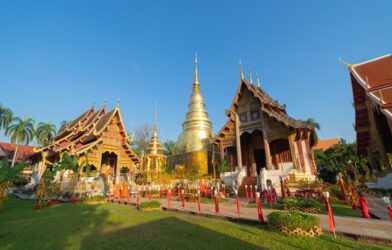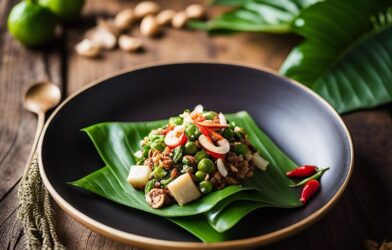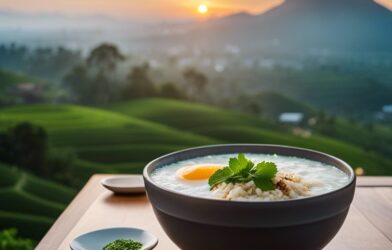Tribe traditions are a fascinating aspect of cultural heritage, offering a window into the rich tapestry of customs and rituals that have been passed down through generations. In Chiang Mai, nestled in the mountains of northern Thailand, the Lisu tribe holds a treasure trove of unique traditions waiting to be discovered. From their vibrant clothing to intricate needlework and spirited festivals, the Lisu people have a rich cultural heritage that is a delight to explore. Join us as we probe into the colorful world of the Lisu tribe and uncover the unique traditions that make them such a special community in Chiang Mai.
The History of the Lisu Tribe
Origin and migration
While the exact origins of the Lisu tribe are still debated among scholars, it is generally believed that they originated from eastern Tibet and Yunnan province in China. Over the centuries, the Lisu people migrated southwards into northern Myanmar, Thailand, and India, seeking new lands for agricultural purposes and escaping political turmoil. Their migration patterns were also influenced by factors such as trade routes and conflicts with neighbouring tribes.
Cultural evolution and influences
While the Lisu people have a rich cultural heritage of their own, they have also been influenced by the cultures of the regions they have inhabited. Being a tribe with a long history of migration, the Lisu have adapted and incorporated aspects of various cultures into their own traditions. This is evident in their unique clothing, language, religious practices, and ceremonies, which have been shaped by interactions with neighbouring tribes, Chinese influences, and missionary activities.
Plus, the Lisu tribe’s cultural evolution has been further influenced by modernization and globalization. Today, younger generations are blending traditional practices with modern lifestyles, leading to a dynamic cultural landscape that continues to evolve.
Types of Unique Lisu Traditions
Some of the unique traditions of the Lisu tribe in Chiang Mai are deeply rooted in their cultural practices and beliefs. These traditions have been passed down through generations, shaping the identity of the Lisu people and distinguishing them from other tribes in the region. Assume that each tradition holds significant meaning and importance within the community.
| Festivals and ceremonies | Wedding and family traditions |
| Agricultural and seasonal practices |
Festivals and ceremonies
One of the key aspects of Lisu culture is their vibrant festivals and ceremonies. These events play a crucial role in uniting the community and celebrating important milestones and traditions. The Lisu people engage in colorful dances, music performances, and rituals during these festivals, showcasing their unique heritage and cultural practices.
Wedding and family traditions
Assuming the role of family as central to their community, Lisu wedding and family traditions hold great significance. Marriages are often arranged by families, with elaborate ceremonies that involve traditional costumes, rituals, and blessings. The wedding rituals symbolize the union of two families and the continuation of cultural heritage within the Lisu tribe.
To research further into Lisu wedding traditions, it is important to note that families play a key role in all aspects of the marriage process. From the arrangement of the marriage to the ceremonies that follow, each step holds cultural significance and is deeply rooted in Lisu tradition.
Agricultural and seasonal practices
To sustain their way of life, the Lisu people engage in agricultural practices that are closely tied to the seasons. From rice cultivation to harvesting crops, the Lisu follow traditional methods that have been passed down over generations. With a deep respect for nature, these practices reflect the harmony between the Lisu tribe and the environment.
With a strong emphasis on sustainable agriculture, the Lisu tribe incorporates traditional farming techniques that prioritize the health of the land and the well-being of the community. These practices not only ensure food security but also promote a balanced ecosystem for future generations.
Traditions
The unique traditions of the Lisu tribe in Chiang Mai are a testament to their rich cultural heritage and strong community ties. Through festivals, wedding ceremonies, and agricultural practices, the Lisu people honor their ancestors and celebrate their identity with pride and reverence.
Traditional Lisu Dress
Unlike other tribes in Chiang Mai, the Lisu people have a unique and vibrant traditional dress that holds great cultural significance. The traditional Lisu attire is a feast for the eyes, with bright colors, intricate embroidery, and elegant designs that showcase the tribe’s rich cultural heritage.
Significance of attire in Lisu culture
While clothing in modern society is often seen as a form of self-expression or fashion, in Lisu culture, attire holds a deeper meaning. The traditional dress is not just a way to cover the body but is a symbol of the tribe’s identity, social status, and connection to their ancestors. Each piece of clothing, from the headdress to the jewelry, is carefully crafted and passed down through generations, signifying the preservation of Lisu traditions and values.
Variations and symbols in traditional clothing
With a keen eye, one can observe a myriad of symbols and variations in Lisu traditional clothing. The colors, patterns, and motifs used in the attire all hold specific meanings related to nature, spirituality, and daily life. For example, the color red symbolizes prosperity and good luck, while intricate floral designs represent the harmony between humans and nature. The embroidery on the clothing often tells stories of the tribe’s history, legends, and beliefs, making each garment a unique piece of art that reflects the Lisu culture.
The Lisu Language and Oral Traditions
Structure and conservation of the Lisu language
Your journey into the unique traditions of the Lisu tribe in Chiang Mai would be incomplete without exploring the fascinating Lisu language. An important aspect of Lisu culture, the language has a distinct structure that reflects the tribe’s rich heritage. Efforts are being made to conserve this unique language, ensuring its survival for future generations.
Storytelling and folklore
An integral part of Lisu oral traditions is the art of storytelling, which has been passed down through generations. Stories, myths, and folklore play a significant role in Lisu culture, preserving their history and values. The tradition of storytelling not only entertains but also educates and connects the Lisu people to their roots.
For instance, Lisu folklore often revolves around nature, with tales of spirits and animals that teach important life lessons. These stories serve as a means of imparting wisdom and morals to younger generations, fostering a sense of community and identity among the Lisu people.
Artistic Expressions of the Lisu People
Music and dance
The Lisu people have a rich tradition of music and dance that plays a significant role in their cultural celebrations and daily life. Music is often accompanied by traditional instruments such as drums, flutes, and stringed instruments, creating a rhythmic and vibrant atmosphere. Their dance forms are energetic and colorful, with intricate footwork and graceful movements that tell stories of their heritage and beliefs.
Handicrafts and folk art
On top of their music and dance, the Lisu people are also known for their exquisite handicrafts and folk art. They are skilled in weaving intricate patterns on textiles, creating stunning clothing and accessories that showcase their craftsmanship and creativity. In addition, their folk art includes vibrant paintings, intricate wood carvings, and beautiful pottery that reflect the natural landscape and beliefs of the Lisu culture.
People from all around the world appreciate the beauty and craftsmanship of Lisu handicrafts, often seeking them out as unique souvenirs or decorations. The attention to detail and cultural significance embedded in each piece make Lisu handicrafts highly desirable and a true representation of the rich artistic expressions of the Lisu people.
Step-by-Step Guide to Experiencing Lisu Traditions
Now let’s probe into a step-by-step guide on how to fully immerse yourself in the unique traditions of the Lisu tribe in Chiang Mai. To ensure you have a memorable and respectful experience, we have broken down the process into two key subsections: Planning your trip to Chiang Mai and Tips for respectful cultural immersion.
Planning your trip to Chiang Mai
| Research | Begin by researching the Lisu tribe’s customs, traditions, and the significance of their various practices. Understand the do’s and don’ts when interacting with the tribe to ensure a culturally sensitive experience. |
| Local Contact | Connect with local guides or cultural organizations that specialize in Lisu tribe experiences. They can help arrange visits to Lisu villages, provide insights into their way of life, and facilitate meaningful interactions with the community. |
Tips for respectful cultural immersion
| Respect Local Customs | Observe and respect the traditional practices of the Lisu tribe, such as clothing, rituals, and taboos. Seek permission before taking photographs and be mindful of your actions to avoid causing offense. |
| Engage with Locals | Embrace the opportunity to interact with Lisu tribe members. Ask questions with genuine curiosity, listen attentively, and participate in community activities when invited. Building rapport and showing interest fosters mutual respect and cultural exchange. |
- Avoid imposing your own beliefs or practices on the Lisu tribe.
- Learn a few basic greetings or phrases in the Lisu language to bridge the cultural gap effectively.
Respectful cultural immersion is important when engaging with indigenous communities like the Lisu tribe. By following these tips and guidelines, you can ensure a meaningful and respectful experience that benefits both you and the local community. Be mindful of, cultural exchange is a two-way street – approach it with an open mind and heart to truly appreciate the richness of Lisu traditions.
Factors Contributing to the Sustainability of Lisu Traditions
Community efforts and local governance
For the Lisu tribe in Chiang Mai, sustainability of their traditions is deeply rooted in community efforts and local governance. The Lisu people have a strong sense of unity and collective responsibility towards preserving their cultural heritage. Assuming leadership roles within the tribe, community elders play a crucial role in passing down traditional knowledge and practices to the younger generation.
Through community gatherings, ceremonies, and festivals, the Lisu tribe actively works together to uphold their customs and values. Local governance structures help in regulating activities that may impact their traditions, ensuring that the core essence of Lisu culture is preserved for future generations. Though modern influences may pose challenges, the commitment of the community to their heritage remains unwavering.
Influence of tourism
You may wonder how tourism impacts the sustainability of Lisu traditions in Chiang Mai. A delicate balance exists between welcoming outsiders to experience their culture and preserving the authenticity of their way of life. As tourists visit Lisu villages to witness traditional dances, crafts, and rituals, there is a potential for both positive and negative influences on the community.
Some Lisu communities have embraced tourism as a means to showcase their traditions and generate income, while others have struggled with maintaining the integrity of their customs amidst the commercialization of their culture. It is necessary for tourists and tour operators to respect the privacy and traditions of the Lisu people, ensuring that their heritage is not exploited for commercial gain. A harmonious relationship between tourism and tradition is vital for the sustainability of Lisu cultural practices.
The Pros and Cons of Cultural Tourism
Many travelers are drawn to cultural tourism as a way to experience the traditions, customs, and way of life of different ethnic groups. However, like any form of tourism, cultural tourism comes with its own set of pros and cons that should be carefully considered.
| Pros | Cons |
| Economic benefits for local communities | Overtourism leading to degradation of cultural sites |
| Promotion of understanding and respect for diverse cultures | Commercialization and loss of authenticity |
| Preservation of traditional crafts and practices | Exploitation of cultural resources for profit |
Economic and educational advantages
Little is known about the positive impact cultural tourism can have on the economic development of local communities. Through the influx of tourists, there is an opportunity for increased revenue generation through the sale of handicrafts, local products, and cultural performances. Additionally, cultural tourism can also facilitate educational exchanges, providing opportunities for cultural exchange and understanding between visitors and locals.
Furthermore, by engaging in cultural tourism activities, visitors can contribute to the preservation and promotion of traditional practices and skills within the community. This exchange of knowledge can help sustain these local traditions for future generations.
Potential threats to cultural integrity
Cultural tourism can sometimes unintentionally lead to the distortion or commodification of local traditions and practices. When cultural experiences are packaged and marketed to suit tourist expectations, there is a risk of diluting the authenticity of the culture being showcased. This can result in a loss of cultural integrity and identity for the community.
Conservationists and cultural advocates often raise concerns about the potential negative impacts of cultural tourism on indigenous communities. The influx of outsiders can disrupt traditional ways of life and challenge the sustainability of these cultures in the face of modern influences.
Culinary Delights of the Lisu Tribe
Despite the modest setting of the Lisu Tribe in Chiang Mai, their culinary traditions are rich and vibrant, providing a glimpse into their unique culture through food.
Traditional Dishes and Ingredients
Traditional Lisu dishes are a blend of vivid flavors and textures, often utilizing ingredients sourced from the surrounding hills and forests. Staples like rice, vegetables, and meats such as chicken, pork, and fish are commonly used in their dishes. Lisu cuisine is known for its use of aromatic herbs and spices like lemongrass, ginger, and coriander, adding depth and complexity to their dishes.
The Role of Food in Lisu Celebrations
Clearly, food plays a central role in Lisu celebrations, symbolizing unity, generosity, and hospitality within the community. During festivals and special occasions, elaborate feasts are prepared, showcasing a variety of traditional dishes that hold cultural significance. These meals bring people together, fostering a sense of belonging and shared identity among the Lisu Tribe.
Culinary traditions are a cornerstone of Lisu culture, reflecting their values, beliefs, and history through the flavors and rituals associated with food. Each bite tells a story, connecting the present with the past, and preserving the heritage of the Lisu Tribe for generations to come.
Spiritual Beliefs and Practices
Overview of Lisu spirituality
All around the world, different cultures possess unique spiritual beliefs and practices that shape their daily lives. The Lisu tribe in Chiang Mai, Thailand, is no exception. With a rich spiritual tradition, the Lisu people hold a deep reverence for nature, ancestors, and spirits that they believe govern their world. Their spirituality is interwoven with their cultural identity, influencing everything from rituals to community gatherings.
Rituals and their meanings in daily life
Now, let’s research into the core of Lisu spirituality – their rituals and their meanings in daily life. Rituals play a significant role in the Lisu tribe, serving as a way to connect with their ancestors, seek blessings from the spirits, and ensure harmony in their surroundings. From elaborate ceremonies to everyday practices, each ritual holds a special significance within the Lisu community.
A common ritual among the Lisu people is the ceremony of offering food and prayers to the spirits of the land before planting crops. This ritual is believed to ensure a bountiful harvest and seek protection from any natural calamities. The intricate dance performances during festivals also hold symbolic meanings, often representing important events in Lisu history or expressing gratitude to the spirits for their blessings. These rituals not only strengthen the bond between the Lisu people and their spiritual beliefs but also foster a sense of unity and tradition within the community.
Modern Life and the Lisu People
The impact of modernization on Lisu traditions
Little by little, the traditional way of life of the Lisu people in Chiang Mai has been influenced by modernization. With the introduction of technology, improved transportation, and access to global markets, the younger generation of Lisu have started to embrace elements of modern living. This shift has raised concerns among the community about the potential loss of their unique cultural traditions.
Balancing tradition with contemporary life
The Lisu people are facing the challenge of balancing their sacred traditions with the demands of contemporary life. While some community members are eager to embrace modernization for better economic opportunities and improved living standards, there is a growing realization that preserving their cultural heritage is imperative for their identity and sense of belonging. The elders play a crucial role in passing down traditions and values to the younger generation, ensuring that the Lisu heritage is not forgotten amidst the rapid changes.
This delicate balance between tradition and modernity is a central theme in the lives of the Lisu people today. As they navigate the complexities of maintaining their cultural practices while adapting to a changing world, the Lisu community must find ways to safeguard their traditions for future generations.

Preserving the Heritage: Efforts and Challenges
Role of the Lisu in preservation
With a deep-rooted connection to their traditions and history, the Lisu people play a crucial role in preserving their unique heritage. This indigenous group takes pride in passing down their customs, rituals, and language from one generation to the next. Through storytelling, traditional ceremonies, and maintaining their distinctive attire, the Lisu community actively participates in safeguarding their cultural identity.
Participation of external organizations
Participation of external organizations in the efforts to preserve the Lisu heritage has been instrumental in providing resources and support. NGOs, cultural institutions, and government bodies have collaborated with the Lisu community to document their traditions, educate the public, and implement sustainable development projects that align with the tribe’s cultural values. This partnership has helped raise awareness about the importance of preserving the Lisu heritage and has contributed to the continued transmission of their unique practices.
Summing up
Ultimately, delving into the unique traditions of the Lisu tribe in Chiang Mai reveals a fascinating blend of cultural practices that have been preserved and passed down through generations. From their vibrant clothing to their intricate music and dance routines, the Lisu tribe showcases a rich heritage that is both captivating and enlightening.
Exploring the customs and rituals of the Lisu tribe provides a deeper understanding of their way of life and the values they hold dear. By immersing oneself in their traditions, one can appreciate the importance of cultural preservation and the beauty of diversity in our world. The Lisu tribe serves as a testament to the resilience and ingenuity of indigenous communities, and their heritage continues to inspire and educate people from all walks of life.













Comments are closed